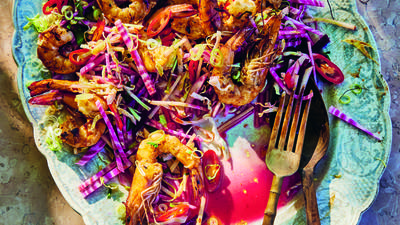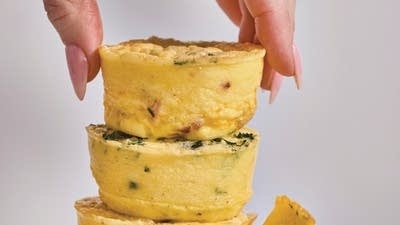
Poppy Tooker, author of the Crescent City Farmers Market Cookbook, is the host of Louisiana Eats! on WWNO in New Orleans. If I could channel Tooker into my house every morning, I'd never have a bad day -- this woman is a flamboyant dynamo. If you want to know about the lost dishes of New Orleans, ask her.
We met in her kitchen. She had the coffee pot on, her three pugs were lined up on the couch, and Tooker had on her trademark bright red lipstick and food-shaped jewelry. On the stove were a couple of cast-iron pots.
 Poppy Tooker and Lynne Rossetto Kasper (Jennifer Russell)
Poppy Tooker and Lynne Rossetto Kasper (Jennifer Russell)
Poppy Tooker: Everybody comes to New Orleans and thinks that the thing to do is go to the French market and have beignets and cafe au lait. They never even learn about the cala. We're going to have calas, which are similar to beignets, but better, with a more interesting history.
Lynne Rossetto Kasper: What exactly is a cala?
PT: It's a rice cake. If you were to go to Africa today, to Ghana or Liberia, you would find the women in the open-air markets making calas. This is a dish that actually made the trip across the Atlantic Ocean with the rice-growing slaves, who were brought here because we didn't know how to grow rice. The cala became a very important part of New Orleans' history.
We are talking about the time before the Louisiana Purchase, which of course happened in 1803. The city was ruled by the Code Noir; in the Code Noir, it laid out all the regulations for how the white people, the slaves and the free people of color lived here together. What a lot of people don't appreciate is that the free people of color owned property, they were educated, they were doctors and lawyers, they sent their kids for higher education to Europe. It was a very different climate than in the rest of the U.S.
In the Code Noir there were two rules. No. 1, all slaves were required by law to have at least one day a week off. The slaves' day off most often was Sunday. Many of them would become street vendors. They would call out, "Calas, calas! Belles calas tout chauds, madame, belles calas tout chauds!" Which means beautiful calas, very hot.
The other thing in the Code Noir I really believe reflects on the cala tradition. It is said if a slave came to you, demanded his price, and could pay it, then you were required by law to take his money and let him go. Undoubtedly, it was this historic rice cake that actually ended up buying freedom for many of them and their families. I'd say that's a lot more interesting and historic than some old beignet.
 Recipe: Calas
Recipe: Calas
LRK: How do you make it?
PT: We eat more rice here in southern Louisiana than just about any place else except for Asia. We always have some leftover rice in the refrigerator. We're going to start off with 2 cups of leftover cooked rice. To those 2 cups of rice, we're going to add 6 tablespoons of flour, 2 teaspoons of baking powder and 3 heaping tablespoons of sugar. We mix the dry ingredients together, then we're going to sprinkle on a little bit of vanilla. For the binding agent we add two raw eggs. This is going to make a nice, tight batter.
LRK: It's not a soft batter, let's put it this way. This is going to be pretty easy to shape?
PT: When it comes to shaping it, my preferred method is with a pair of tablespoons, like oval soup spoons.
LRK: We're going to go over to the stove, where you have a big, cast-iron pot.
PT: Make sure that we have a good frying temperature. I just dropped a grain of rice in. If the grain pops up to the top and starts bubbling, then we're all set.
LRK: You've taken a heaping tablespoon of the batter and you've put it into the tablespoon. The other tablespoon is sort of spooning over it. You've formed almost an oval, but it has a triangular shape to it.
PT: You just spoon it gently into the hot oil. Then it pops up to the top and it begins to fry.
The really great thing with the calas is that they're foolproof, they're obedient -- there are not very many obedient foods. When you put them in the pot, they brown on one side, then they turn themselves over and brown on the other. You don't have to mind them.
LRK: It's puffing up a bit too. There's that leavening going to work. How long are they going to take?
PT: They’re just going to take until they're brown on both sides. Did you see it just turn over?
LRK: Yes, it just flipped its little, old self right over.
 Tooker's recipe: Creole Cream Cheese
Tooker's recipe: Creole Cream Cheese
PT: I'm going to tell you the reason why I have been on this crusade to save the cala and bring it back. Over 20 years ago, I did a festival. I knew how to make them, but I hadn't grown up with them. I didn't know how special a part of the culture they really were until an old man came up to the booth and said, "Lady, my momma used to make these all the time when I was a little boy. I had completely forgotten all about that until just now. Could you please tell me, how do you make these?"
It was so clear in this man's face that the taste of the calas had brought his mother back alive to him. It doesn't matter what race, religion or nationality you are, the thing that makes us all human is we all have to eat to live. The place where we all come together is at the table.
I set out to save the cala. I did it by talking about it in cooking classes and by telling anybody in the food world who would listen. We really started to make some traction. Then about 10 years ago, I started making them savory style. It caught the attention of some local chefs, and it started showing up on restaurant menus. You can find savory calas at Frank Brigtsen's restaurant and at Cochon, Stephen Stryjewski and Donald Link's restaurant.
They're helping me do what my little, great-grandmother used to say: "Poppy, eat it to save it." She meant clean your plate. But in the work that I've been involved in, it makes all the more sense because if we don't eat it, how are we going to save it?
LRK: They really look gorgeous.
PT: We're going to sprinkle them with some powdered sugar.
LRK : All the rice on the surface has gotten really crunchy. It's so soft inside, bread-like and cakey, but much more interesting than if it were just a straight flour dough.
PT: Are you ready to help me eat them to save them?
LRK: I think so. Saving is part of my way of life.
PT: If anybody can help me bring the cala back, I know it's you.
LRK: Now we have to spread it around the country.
Before you go...
Each week, The Splendid Table brings you stories that expand your world view, inspire you to try something new, and show how food connects us all. We rely on your generous support. For as little as $5 a month, you can have a lasting impact on The Splendid Table. And, when you donate, you’ll join a community of like-minded individuals who love good food, good conversation, and kitchen companionship. Show your love for The Splendid Table with a gift today.
Thank you for your support.
Donate today for as little as $5.00 a month. Your gift only takes a few minutes and has a lasting impact on The Splendid Table and you'll be welcomed into The Splendid Table Co-op.




